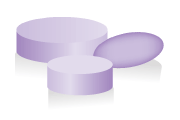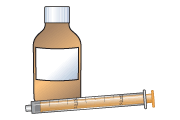Potassium chloride for low potassium levels
This leaflet is for parents and carers about how to use this medicine in children. Our information may differ from that provided by the manufacturers, because their information usually relates to adults. Read this leaflet carefully. Keep it somewhere safe so that you can read it again.
If you have been given effervescent tablets, make sure you understand how to dissolve the tablets in water and how much to give your child. The packaging for different effervescent tablets look similar, so check you are giving the right one.
Name of medicine
Potassium chloride
Brand names: Sando-K (effervescent tablets), Kay-Cee-L (liquid); Slow-K (modified release tablets)
Modified-release tablets: Slow-K
Why is it important for my child to take Potassium chloride?
Potassium is important for the heart, nerves and muscles to work properly. Your child may have low potassium levels because they have too little in their diet (e.g. premature babies) or because they have lost potassium because pf illness or kidney problems. Potassium chloride will help to keep your children’s potassium at a normal level.
What is Potassium chloride available as?
- Effervescent (fizzy) tablets (Sandoz-K): Each tablet contains 470 mg (12 mmol) potassium
- Modified-release tablets (Slow-K) : each tablet contains 600 mg (8 mmol)
- Liquid medicine: each mL contains 1 mmol potassium
When should I give Potassium chloride
The Potassium chloride is usually given twice each day. Give one dose in the morning and one in the evening. Ideally these times are 10–12 hours apart. For example, this could be between 7am and 8am and between 7pm and 8pm.
Try to give the medicine(s) at about the same times each day, to help you remember.
How much should I give?
Your doctor will work out the amount of Potassium chloride (the dose) that is right for your child. The dose will be shown on the medicine label.
It is important that you follow your doctor’s instructions about how much to give.
How should I give Potassium chloride?

Effervescent (Sando-K) tablets
You will need to dissolve the tablet in water and give your child some or all of this mixture. Detailed instructions on how to do this are provided on the back page of this leaflet . This information is also available in a leaflet on our website.

Modified-release (Slow-K) tablets
The tablets should be taken with, or just after, a meal. They should be swallowed whole, with a glass of water, squash or juice. Your child should stay upright for 20-30 minutes after taking the tablet. They should not chew the tablet.

Liquid medicine
- Shake the medicine well.
- Measure out the right amount using an oral syringe or a medicine spoon. You can get these from your pharmacist. Do not use a kitchen teaspoon as it will not give the right amount.
When should the medicine start working?
The medicine should start working after about 3 days, although you will not see any difference in your child.
What if my child is sick (vomits)?
If your child is sick less than 30 minutes after having a dose of Potassium chloride, give them the same dose again.
If your child is sick more than 30 minutes after having a dose of Potassium chloride, you do not need to give them another dose. Wait until the next normal dose.
What if I forget to give it?
If you remember up to 4 hours after you should have given a dose, give your child the missed dose. For example, if you usually give a dose at about 7 am, you can give the missed dose at any time up to 11 am. If you remember after that time, do not give the missed dose. Just give the next dose as usual.
Never give a double dose of Potassium chloride.
What if I give too much?
If you think you may have given your child too much Potassium chloride, contact your doctor or local NHS services (details at end of leaflet). Have the medicine or packaging with you if you telephone for advice.
It may be dangerous to give too much Potassium chloride.
Are there any possible side effects?
We use medicines to make our children better, but sometimes they have other effects that we don’t want (side effects).
Side effects you must do something about
If your child gets bad stomach pain, brings up (vomits) blood or their stools (poo) are very dark, contact your doctor or take your child to hospital straight away, as they may have an ulcer.
Other side-effects you need to know about
Your child may get stomach pain or cramps, and may feel sick (nausea) or be sick (vomit). Giving the medicine with some food or milk may help. These side effects usually wear off after a few days as your child gets used to the medicine. If they are still a problem after one week contact your doctor.
There may sometimes be other side effects that are not listed above. If you notice anything unusual and are concerned, contact your doctor. You can report any suspected side effects to a UK safety scheme at mhra.gov.uk/yellowcard
Can other medicines be given at the same time as Potassium chloride?
- You can give your child medicines that contain paracetamol or ibuprofen, unless your doctor has told you not to.
- Potassium chloride should not be taken with some medicines. Tell your doctor or pharmacist about any other medicines your child is taking before giving Potassium chloride.
Check with your doctor or pharmacist before giving any other medicines to your child. This includes herbal and complementary medicines.
Is there anything else I need to know about this medicine?
It is important to attend any clinic appointments to ensure that your child is getting the right dose and to monitor if potassium levels are too high or too low – this is critical for the safety of your child.
- Your child’s blood will be tested regularly to check that the levels of potassium are correct. It is vital that your child has these blood tests, because they may become unwell if their potassium levels are too high or too low.
- Your doctor may change the amount of potassium chloride to give your child depending on the result of a blood test. Check how much to give each time you get a new prescription. If you are not sure, check with your doctor.
- The packaging for some phosphate and potassium effervescent tablets looks similar. If you child has more than one effervescent medicine, make sure you are giving the right medicine at the right time.
- If your child is taking effervescent tablets, make sure you understand how to dissolve the tablets in water and how much to give your child. If you are not sure, ask your doctor, nurse or pharmacist for help.
General advice about medicines
- Try to give medicines at about the same times each day, to help you remember.
- If you feel your child is not improving, do not give extra medicine. Please continue with the regular dose and speak to your doctor.
- Only give this medicine to your child. Never give it to anyone else, even if their condition appears to be the same, as this could do harm.
- If you think someone else may have taken the medicine by accident, contact your doctor or NHS local services (details at end of leaflet) for advice.
- Make sure that you always have enough medicine. Order a new prescription at least 2 weeks before you will run out.
- Make sure that the medicines you have at home have not reached the ‘use by’ date on the packaging. Give old medicines to your pharmacist to dispose of.
Where should I keep this medicine?
- Keep the medicine in a cupboard, away from heat and direct sunlight.
- It does not need to be kept in the fridge.
- You may need to keep liquid medicine in the fridge – check the instructions on the bottle. Make sure the medicine does not freeze.
- Make sure that children cannot see or reach the medicine.
- Keep the medicine in the container it came in.
Who to contact for more information?
Your doctor, pharmacist or nurse will be able to give you more information about Potassium chloride and about other medicines used to treat potassium depletion.
England: NHS 111
Tel 111
www.nhs.ukScotland: NHS 24
Tel 111
www.nhs24.scotNorthern Ireland: NI Direct
Wales: NHS 111 Wales
Tel 111
www.111.wales.nhs.ukCopyright disclaimer
Version [2]. © NPPG, RCPCH and WellChild, all rights reserved. Review by August 2024.
The primary source for the information in this leaflet is the British National Formulary for Children. For details on any other sources used for this leaflet, please contact us through our website, www.medicinesforchildren.org.uk.
We take great care to make sure that the information in this leaflet is correct and up-to-date. However, medicines can be used in different ways for different patients. It is important that you ask the advice of your doctor or pharmacist if you are not sure about something. This leaflet is about the use of these medicines in the UK, and may not apply to other countries. The Royal College of Paediatrics and Child Health (RCPCH), the Neonatal and Paediatric Pharmacists Group (NPPG), WellChild and the contributors and editors cannot be held responsible for the accuracy of information, omissions of information, or any actions that may be taken as a consequence of reading this leaflet.
